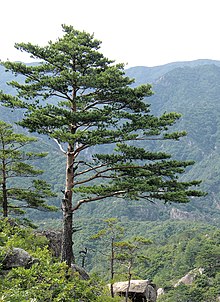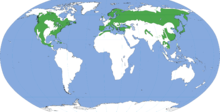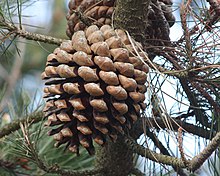Pine
| Pine Temporal range:
| |
|---|---|

| |
| Pinus densiflora (Korean red pine), North Korea | |
| Scientific classification | |
| Kingdom: | Plantae |
| Clade: | Tracheophytes |
| Clade: | Gymnospermae |
| Division: | Pinophyta |
| Class: | Pinopsida |
| Order: | Pinales |
| Family: | Pinaceae |
| Subfamily: | Pinoideae |
| Genus: | Pinus L. |
| Type species | |
L.
| |
| Subgenera | |
See List of Pinus species for complete taxonomy to species level. See list of pines by region for list of species by geographic distribution. | |

| |
| Range of Pinus | |
| Synonyms | |
| |
A pine is any conifer tree or shrub in the genus Pinus (/ˈpaɪnuːs/)[1] of the family Pinaceae. Pinus is the sole genus in the subfamily Pinoideae.
World Flora Online, created by the Royal Botanic Gardens, Kew, and Missouri Botanical Garden, accepts 187 species names of pines as current, together with more synonyms.[2] The American Conifer Society (ACS) and the Royal Horticultural Society accept 121 species.
Pines are commonly found in the Northern Hemisphere.
Pine may also refer to the lumber derived from pine trees; it is one of the more extensively used types of lumber. The pine family is the largest conifer family, and there are currently 818 named cultivars (or trinomials) recognized by the ACS.[3] It is also a well-known type of Christmas tree.
Description
Pine trees are

Pines are long lived and typically reach ages of 100–1,000 years, some even more. The longest-lived is the
The spiral growth of branches, needles, and
Bark

The bark of most pines is thick and scaly, but some species have thin, flaky bark.[10] The branches are produced in regular "pseudo whorls", actually a very tight spiral but appearing like a ring of branches arising from the same point. Many pines are uninodal, producing just one such whorl of branches each year, from buds at the tip of the year's new shoot, but others are multinodal, producing two or more whorls of branches per year.
Foliage
Pines have four types of leaf:
- Seed leaves (cotyledons) on seedlings are borne in a whorl of 4–24.
- Juvenile leaves, which follow immediately on seedlings and young plants, are 2–6 centimetres (3⁄4–2+1⁄4 inches) long, single, green or often blue-green, and arranged spirally on the shoot. These are produced for six months to five years, rarely longer.
- Scale leaves, similar to bud scales, are small, brown and not photosynthetic, and arranged spirally like the juvenile leaves.
- Needles, the adult leaves, are green (growing tipis damaged (e.g. eaten by an animal), the needle fascicles just below the damage will generate a stem-producing bud, which can then replace the lost growth tip.
Cones

Pines are
The seeds are mostly small and winged, and are
Taxonomy
Pines are gymnosperms. The genus is divided into two subgenera based on the number of fibrovascular bundles in the needle. The subgenera can be distinguished by cone, seed, and leaf characters:
- The subgenus is also named diploxylon, on account of its two fibrovascular bundles.
- Pinus subg. Strobus, the white, or soft pine group. Its members usually have softer wood and five needles per fascicle.[13]The subgenus is also named haploxylon, on account of its one fibrovascular bundle.
Phylogenetic evidence indicates that both subgenera have a very ancient divergence from one another.[14] Each subgenus is further divided into sections and subsections.
Many of the smaller groups of Pinus are composed of closely related species with recent divergence and history of hybridization. This results in low morphological and genetic differences. This, coupled with low sampling and underdeveloped genetic techniques, has made taxonomy difficult to determine.[15] Recent research using large genetic datasets has clarified these relationships into the groupings we recognize today.
Etymology
The modern English name "pine" derives from Latin pinus, which some have traced to the Indo-European base *pīt- ‘resin’ (source of English pituitary).
Phylogeny
Pinus is the largest genus of the Pinaceae, the pine family, which first appeared in the Jurassic period.[17] Based on recent Transcriptome analysis, Pinus is most closely related to the genus Cathaya, which in turn is closely related to spruces. These genera, with firs and larches, form the pinoid clade of the Pinaceae.[14] Pines first appeared during the Early Cretaceous, with the oldest verified fossil of the genus being Pinus yorkshirensis from the Hauterivian-Barremian boundary (~130-125 million years ago) from the Speeton Clay, England.[18]
The evolutionary history of the genus Pinus has been complicated by hybridization. Pines are prone to inter-specific breeding. Wind pollination, long life spans, overlapping generations, large population size, and weak reproductive isolation make breeding across species more likely.[19] As the pines have diversified, gene transfer between different species has created a complex history of genetic relatedness.
| Jin et al. 2021[20] | Stull et al. 2021[14] | ||||||||||||||||||||||||||||||||||||||||||||||||||||||||||||||||||||||||||||||||||||||||||||||||||||||||||||||||||||||||||||||||||||||||||||||||||||||||||||||||||||||||||||||||||||||||||||||||||||||||||||||||||||||||||||||||||||||||||||||||||||||||||||||||||||||||||||||||||||||||||||||||||||||||||||||||||||||||||||||||||||||||||||||||||||||||||||||||||||||||||||||||||||||||||||||||||||||||||||||||||||||||||||||
|---|---|---|---|---|---|---|---|---|---|---|---|---|---|---|---|---|---|---|---|---|---|---|---|---|---|---|---|---|---|---|---|---|---|---|---|---|---|---|---|---|---|---|---|---|---|---|---|---|---|---|---|---|---|---|---|---|---|---|---|---|---|---|---|---|---|---|---|---|---|---|---|---|---|---|---|---|---|---|---|---|---|---|---|---|---|---|---|---|---|---|---|---|---|---|---|---|---|---|---|---|---|---|---|---|---|---|---|---|---|---|---|---|---|---|---|---|---|---|---|---|---|---|---|---|---|---|---|---|---|---|---|---|---|---|---|---|---|---|---|---|---|---|---|---|---|---|---|---|---|---|---|---|---|---|---|---|---|---|---|---|---|---|---|---|---|---|---|---|---|---|---|---|---|---|---|---|---|---|---|---|---|---|---|---|---|---|---|---|---|---|---|---|---|---|---|---|---|---|---|---|---|---|---|---|---|---|---|---|---|---|---|---|---|---|---|---|---|---|---|---|---|---|---|---|---|---|---|---|---|---|---|---|---|---|---|---|---|---|---|---|---|---|---|---|---|---|---|---|---|---|---|---|---|---|---|---|---|---|---|---|---|---|---|---|---|---|---|---|---|---|---|---|---|---|---|---|---|---|---|---|---|---|---|---|---|---|---|---|---|---|---|---|---|---|---|---|---|---|---|---|---|---|---|---|---|---|---|---|---|---|---|---|---|---|---|---|---|---|---|---|---|---|---|---|---|---|---|---|---|---|---|---|---|---|---|---|---|---|---|---|---|---|---|---|---|---|---|---|---|---|---|---|---|---|---|---|---|---|---|---|---|---|---|---|---|---|---|---|---|---|---|---|---|---|---|---|---|---|---|---|---|---|---|---|---|---|---|---|---|---|---|---|---|---|---|---|---|---|---|---|---|---|---|---|---|---|---|---|---|---|---|---|---|---|---|
|
|
Distribution and habitat
Pines are native to the
Pines may be found in a very large variety of environments, ranging from semi-arid desert to rainforests, from sea level up to 5,200 m (17,100 ft), from the coldest to the hottest environments on Earth. They often occur in mountainous areas with favorable soils and at least some water.[22]
Various species have been introduced to temperate and
Ecology

Pines grow well in acid soils, some also on
Pine trees are beneficial to the environment since they can remove carbon dioxide from the atmosphere. Although several studies have indicated that after the establishment of pine plantations in grasslands, there is an alteration of carbon pools including a decrease of the soil organic carbon pool.[24]
Several species are adapted to extreme conditions imposed by elevation and latitude (e.g. Siberian dwarf pine,
Pine pollen may play an important role in the functioning of detrital food webs.[26] Nutrients from pollen aid detritivores in development, growth, and maturation, and may enable fungi to decompose nutritionally scarce litter.[26] Pine pollen is also involved in moving plant matter between terrestrial and aquatic ecosystems.[26]
Wildlife
Pine needles serve as food for various
The seeds are commonly eaten by birds, such as grouse, crossbills, jays, nuthatches, siskins, and woodpeckers, and by
Uses

Lumber and construction
Pines are among the most commercially important tree species valued for their timber and wood pulp throughout the world.[28][29] In temperate and tropical regions, they are fast-growing softwoods that grow in relatively dense stands, their acidic decaying needles inhibiting the sprouting of competing hardwoods.[citation needed] Commercial pines are grown in plantations for timber that is denser and therefore more durable than spruce (Picea). Pine wood is widely used in high-value carpentry items such as furniture, window frames, panelling, floors, and roofing, and the resin of some species is an important source of turpentine.
Because pine wood has no insect- or decay-resistant qualities after logging, in its untreated state it is generally recommended for indoor construction purposes only (indoor drywall framing, for example). For outside use, pine needs to be treated with copper azole, chromated copper arsenate or other suitable chemical preservative.[30]
Ornamental uses

Many pine species make attractive ornamental plantings for
Farming
When grown for sawing timber, pine plantations can be harvested after 25 years, with some stands being allowed to grow up to 50 (as the wood value increases more quickly as the trees age). Imperfect trees (such as those with bent trunks or forks, smaller trees, or diseased trees) are removed in a "thinning" operation every 5–10 years. Thinning allows the best trees to grow much faster, because it prevents weaker trees from competing for sunlight, water, and nutrients. Young trees removed during thinning are used for pulpwood or are left in the forest, while most older ones are good enough for saw timber.[34]
A 30-year-old commercial pine tree grown in good conditions in Arkansas will be about 0.3 m (1 ft) in diameter and about 20 m (66 ft) high. After 50 years, the same tree will be about 0.5 m (1+1⁄2 ft) in diameter and 25 m (82 ft) high, and its wood will be worth about seven times as much as the 30-year-old tree. This however depends on the region, species and silvicultural techniques. In New Zealand, a plantation's maximum value is reached after around 28 years with height being as high as 30 m (98 ft) and diameter 0.5 m (1+1⁄2 ft), with maximum wood production after around 35 years (again depending on factors such as site, stocking and genetics). Trees are normally planted 3–4 m apart, or about 1,000 per hectare (100,000 per square kilometre).[35][36][37][38]
Food and nutrients
The seeds (pine nuts) are generally edible; the young male cones can be cooked and eaten, as can the bark of young twigs.[39] Some species have large pine nuts, which are harvested and sold for cooking and baking. They are an essential ingredient of pesto alla genovese.
The soft, moist, white inner bark (
A tea is made by steeping young, green pine needles in boiling water (known as tallstrunt in Sweden).[40] In eastern Asia, pine and other conifers are accepted among consumers as a beverage product, and used in teas, as well as wine.[41] In Greece, the wine retsina is flavoured with Aleppo pine resin.
Pine needles from Pinus densiflora were found to contain 30.54 milligram/gram of proanthocyanidins when extracted with hot water.[42] Comparative to ethanol extraction resulting in 30.11 mg/g, simply extracting in hot water is preferable.
In
Culture

Pines have been a frequently mentioned tree throughout history, including in literature, paintings and other art, and in religious texts.
Literature
Writers of various nationalities and ethnicities have written of pines. Among them, John Muir,[44] Dora Sigerson Shorter,[45] Eugene Field,[46] Bai Juyi,[47] Theodore Winthrop,[48] and Rev. George Allan D.D.[49]
Art
Pines are often featured in art, whether painting and fine art,[50] drawing,[51] photography, or folk art.
Religious texts
Pine trees, as well as other conifers, are mentioned in some verses of the Bible, depending on the translation. In the Book of Nehemiah 8:15, the King James Version gives the following translation:[52]
"And that they should publish and proclaim in all their cities, and in Jerusalem, saying, Go forth unto the mount, and fetch olive branches, and pine branches [emphasis added], and myrtle branches, and palm branches, and branches of thick trees, to make booths, as it is written."
However, the term here in Hebrew (עץ שמן) means "oil tree" and it is not clear what kind of tree is meant. Pines are also mentioned in some translations of Isaiah 60:13, such as the King James:
"The glory of Lebanon shall come unto thee, the fir tree, the pine tree, and the box together, to beautify the place of my sanctuary; and I will make the place of my feet glorious."
Again, it is not clear what tree is meant (תדהר in Hebrew), and other translations use "pine" for the word translated as "box" by the King James (תאשור in Hebrew).
Some botanical authorities believe that the Hebrew word "ברוש" (bərōsh), which is used many times in the Bible, designates
Chinese culture
The pine is a motif in Chinese art and literature, which sometimes combines painting and poetry in the same work. Some of the main symbolic attributes of pines in Chinese art and literature are longevity and steadfastness: the pine retains its green needles through all the seasons. Sometimes the pine and cypress are paired. At other times the pine, plum, and bamboo are considered as the "
See also
- El Pino (The Pine Tree)
- Pine barrens
- Pine-cypress forest
- Pine Tree Flag
- Tree of Peace
References
- ^ "Pinus". Medical Definition of PINUS. Merriam-Webster Medical Dictionary.
- ^ "Pinus (L.)". World Flora Online. The World Flora Online Consortium. 2022. Retrieved 14 August 2022.
- ^ a b "Pinus / pine | Conifer Genus". American Conifer Society. Retrieved 1 March 2022.
- ^ a b Fattig P (23 January 2011). "Tallest of the tall". Mail Tribune. Medford, Oregon. Archived from the original on 23 September 2012. Retrieved 27 January 2011.
- JSTOR 1313736.
- ^ Miranda, Carolina A. (28 February 2015). "Follow-up: More tales of the Prometheus tree and how it died". Los Angeles Times. Retrieved 16 October 2020.
- ^ a b Eveleth, Rose (15 November 2012). "How One Man Accidentally Killed the Oldest Tree Ever". Smithsonian. Smithsonian Institution. Retrieved 16 October 2020.
- .
The ratio between two pine needles is 0.618 [...] the angle between the two neighbors is about 135° and the angle between the main stem and each branch is close to 34.4° which is the golden section of 90°
- ^ Bracewell, Ronald; Rawlings, John. "Pinus (Pine) Notes". Trees of Stanford. Retrieved 2 February 2020.
- ^ Porter, VI (2018). Mystique Melodies. Dorrance Publishing.
- ISBN 0-87893-403-0.
- JSTOR 3976.
- ^ ISBN 978-0-472-08921-5. Archivedfrom the original on 2016-05-11.
- ^ from the original on January 10, 2022. Retrieved January 10, 2022.
- PMID 23831459.
- ^ "Where Are You From? - Credo Reference". credoreference.com.
- S2CID 52110440.
- S2CID 85402168.
- PMID 23936218.
- PMID 33941644.
- PMID 30398478.
- ^ "Pine Trees". Basic Biology. 30 August 2020. Retrieved 2019-10-31.
- ^ "Pinus ssp. (tree), General Impact". Global Invasive Species Database. Invasive Species Specialist Group. 13 March 2006. Archived from the original on 26 July 2011. Retrieved 2 March 2011.
- PMID 33559772.
- ^ "Pinus sabiniana Dougl". www.srs.fs.usda.gov. Retrieved 2022-05-04.
- ^ .
- ^ "Pine Sawflies". Penn State Extension. Retrieved 2022-05-04.
- ^ "Choosing a Timber Species - Timber Frame HQ". Timber Frame HQ. Retrieved 2018-01-04.
- ^ "Trees for pulp" (PDF). Paper.org. Archived from the original (PDF) on 2017-11-18. Retrieved 2018-01-04.
- ^ "Timber treatment". weathertight.org.nz. 2010-10-18. Retrieved 18 May 2019.
- ^ "5 Ways to Decorate with Pine Boughs". Home Decorating Trends - Homedit. 2012-12-04. Retrieved 2018-01-04.
- ^ McAfee MJ (1911). The pine-needle basket book. The Library of Congress. New York : Pine-Needle Pub. Co.
- ^ Solanki S (2018-12-17). "5 radical material innovations that will shape tomorrow". CNN Style. Retrieved 2018-12-17.
- ^ "The Pine Plantation Rotation" (PDF). Forests NSW. Archived (PDF) from the original on 2016-03-08. Retrieved 1 April 2016.
- ^ Frank A. Roth II, Extension Forester. "Thinning to improve pine timber" (PDF). University of Arkansas Division of Agriculture. Archived from the original (PDF) on 9 October 2016. Retrieved 3 April 2016.
- ^ "NZ Farm Forestry - Radiata pine silviculture in Chile". www.nzffa.org.nz. Retrieved 2020-08-03.
- ^ "NZ Farm Forestry - NZFFA guide sheet No. 1: An Introduction to Growing Radiata Pine". www.nzffa.org.nz. Retrieved 2020-08-03.
- S2CID 219518345.
- )
- ^ OCLC 799792.
- PMID 21535752.
- PMID 21994521.
- PMID 25556061.
- ^ Muir J. The Yosemite.
- ^ Shorter DS. The Secret. Archived from the original on 2018-01-05. Retrieved 2018-01-04.
- ^ Field, Eugene. "Norse Lullaby". Poems of Childhood/Norse Lullaby. Archived from the original on 2018-01-04. Retrieved 2018-01-04.
- ^ Bai Juyi "The Pine Trees in the Courtyard" Archived 2018-01-04 at the Wayback Machine
- ^ Winthrop T. Life in the Open Air. Archived from the original on 2018-01-04. Retrieved 2018-01-04.
- ^ "Is your war-pipe asleep". The Book of Scottish Song. Archived from the original on 2018-01-04. Retrieved 2018-01-04.
- ^ Pissarro C (1903). "Work by Camille Pissarro". Retrieved 1 April 2018.
- ^ Britton NL, Brown A (1913). "Pinus strobus L". Illustrated flora of the northern states and Canada. Vol. 1. USDA-NRCS PLANTS Database. Retrieved 2018-01-04.
- ^ "NEHEMIAH 8:15 KJV". www.kingjamesbibleonline.org. Retrieved 2018-01-04.
- ^ "Hosea 14:8".
- ^ Wycliffe Bible Dictionary. entry Plants: Fir: Hendrickson Publishers. 1975.
- ^ "Isaiah 44:14".
- ^ Biblia Hebraica Stuttgartensia ad loc.
- ISBN 0-415-00228-1, sub "Pine".
Bibliography
- Farjon A (2005). Pines (2nd ed.). Leiden: E. J. Brill. ISBN 90-04-13916-8.
- Little Jr EL, Critchfield WB (1969). Subdivisions of the Genus Pinus (Pines). Misc. Publ. 1144 (Superintendent of Documents Number: A 1.38:1144) (Report). US Department of Agriculture.
- Richardson DM, ed. (1998). Ecology and Biogeography of Pinus. Cambridge, England: Cambridge University Press. p. 530. ISBN 0-521-55176-5.
- Sulavik SB (2007). Adirondack; Of Indians and Mountains, 1535-1838. Fleischmanns, NY: Purple Mountain Press. pp. 244 pages. ISBN 978-1-930098-79-4.
- Mirov NT (1967). The Genus Pinus. New York, NY: Ronald Press.
- "Classification of pines". The Lovett Pinetum Charitable Foundation. Archived from the original on 2004-06-03. Retrieved 2004-01-17.
- Mirov NT, Stanley RG (1959). "The Pine Tree". Annual Review of Plant Physiology. 10: 223–238. .
- Philips R (1979). Trees of North America and Europe. New York, NY: Random House, Inc. ISBN 0-394-50259-0.
- Earle, Christopher J., ed. (2018). "Pinus". The Gymnosperm Database.
External links
- 40 Species of Pine Trees You Can Grow by The Spruce
- Jepson eFlora, The Jepson Herbarium, University of California, Berkeley, covers Californian species
- Pinus in Flora of North America
- Pinus in the USDA Plants Database
- Conifer Database
